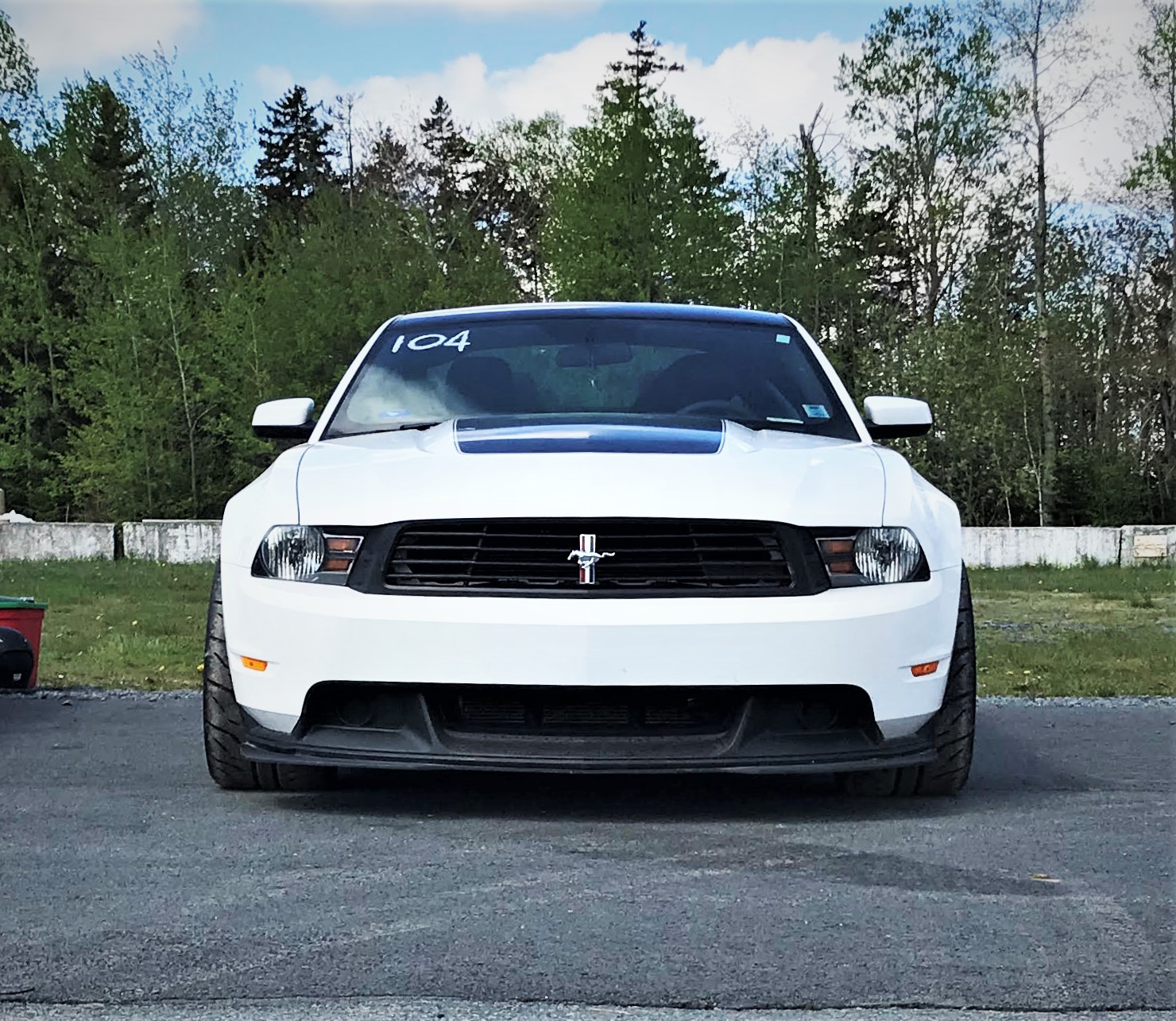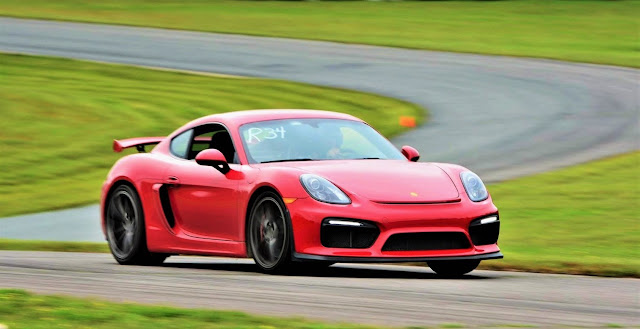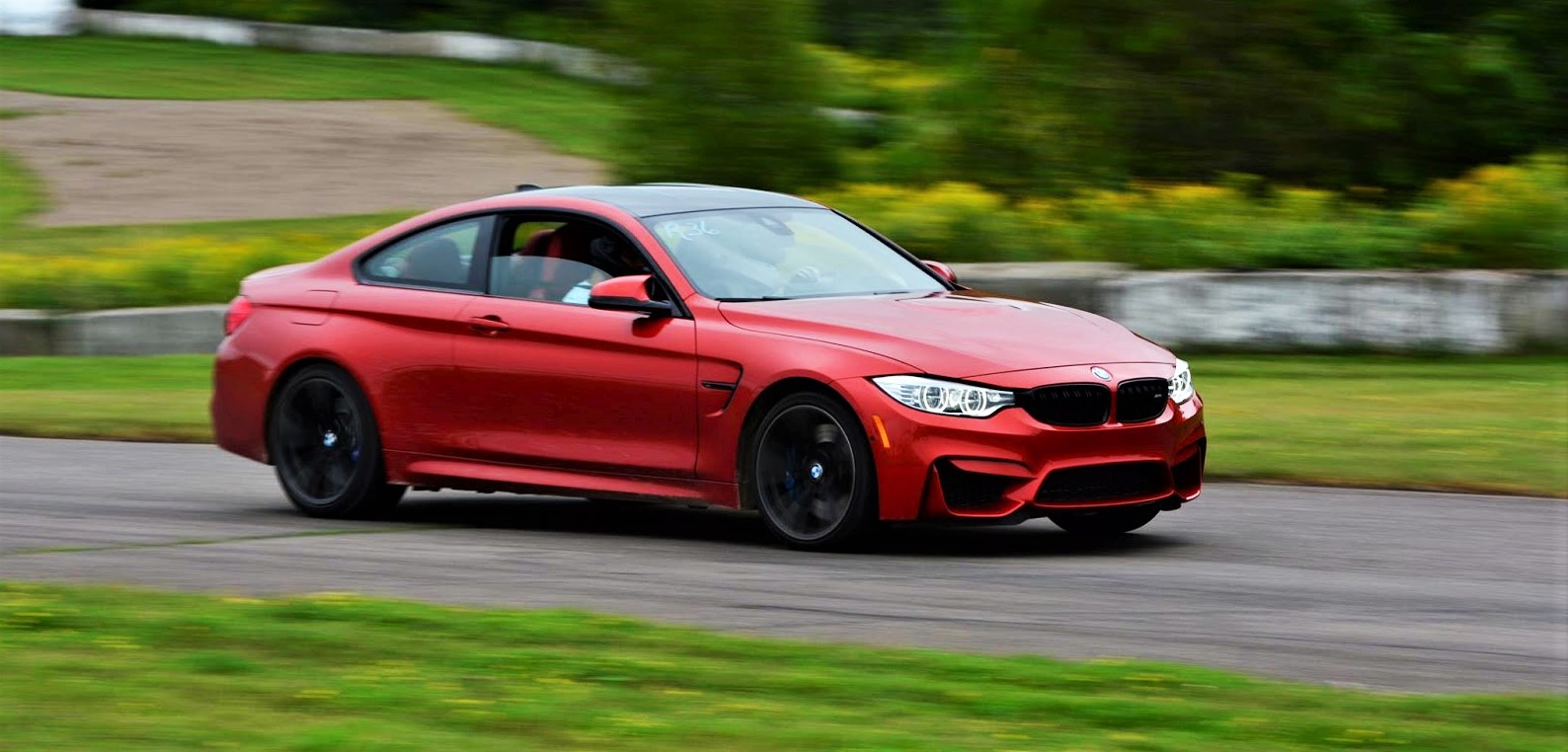FWD is for kids. Anyone can go fast in a FWD car. Real drivers learn to handle RWD. That's what a buddy said when I was talking about managing throttle in FWD vs RWD in one of the turns on our track. Another friend of mine who is a diehard VW fan just bought a new Mk7 Golf R. Naturally, we argued about Golf R vs Focus RS as we've done countless times in the past. This time, though, the Civic Type R came up, and he said it doesn't matter because "it's FWD." If you agree with all of that, you can't take this new Type R seriously. You might as well stop reading now and move on. And frankly, Honda has done a pretty good job with the styling to convince you NOT to take this car seriously.. But you might be making a mistake.
A proper, thoroughbred sports car needs to have RWD in my book. But we aren't talking about thoroughbreds here. We are talking about very-hot hatchbacks based on compact economy cars. So the question boils down to FWD or AWD? Well, what are the advantages of AWD over FWD?
- Front wheels have to do less propulsion work so more of the grip budget can be reserved for braking and steering.
- Less understeer due to the above (all else being equal).
- You have more traction by putting the rear wheels to work (aside from just keeping the rear end off the road).
- More even tire wear.
- Potential for far more flexibility to control yaw under power with a good rear end.
- .... *crickets*

Let's first get the performance numbers out of the way. 0-60 mph happens in 4.9 seconds, which I think makes this the fastest production FWD car ever tested by Car & Driver. They didn't state that, but all the greats - Neon SRT4, Cobalt SS (turbo), Mazdaspeed3 - are 5 second plus cars. 100 mph soon follows, coming in 11.5 seconds from a stop - another record. If you get the launch right - admittedly, a huge challenge for a high HP, high torque, FWD car like this - you are in Audi S4/S5 and BMW 340i/440i territory. If you are on track and don't have to worry about launch, this will be seriously quick. The rest of the numbers are equally impressive, if not even more so. Here's how it stacks up against the Focus RS and WRX STI, on paper.
| 2017 Civic Type R | 2016 Focus RS | 2015 WRX STI | |
|---|---|---|---|
| 0-60 mph | 4.9 s | 4.6 s | 4.7 s |
| 0-100 mph | 11.5 s | 12.2 s | 12.0 s |
| 5-60 mph | 5.8 s | 5.7 s | 6.7 s |
| 1/4 mile | 13.5 s @ 108 mph | 13.4 s @ 105 mph | 13.4 s @ 104 mph |
| Braking 70-0 mph | 142 ft | 158 ft | 159 ft |
| Grip (lat-g) | 1.02 g | 0.98 g | 0.90 g |
| 60-100 mph (calc) | 6.6 s | 7.6 s | 7.3 s |
All numbers are from Car & Driver tests. Two things are very obvious. First is that the Type R has a clear launch disadvantage, as evident by slower 0-60 and 1/4 mile times despite quicker trap and 0-100 numbers. Second is that the Type R outperforms everywhere else. Acceleration, grip, braking, etc. The five Forza evaluation categories are speed, acceleration, launch, handling, and braking. The Type R would beat the other two in all but launch, and perhaps tie the RS in top speed. The last metric - 60-100 mph - is calculated by me, to try and isolate acceleration from launch. If 3 and 4 mph margins in 1/4 mile trap speed vs the RS and the STI are not enough to convince you of the R's advantage beyond launch, then the 60-100 mph time should seal the deal. Now, I know for a fact that the RS is disadvantaged by gearing in the 100 mph run, since its shift point is well into the 90-100 mph range, but I doubt that is worth a full second in 60-100 mph.

Grip
When it comes to grip, Honda cheated a little. For the 'Ring lap time, they spec'd Michelin Pilot Sport Cup 2 tires that, so far, they haven't decided to sell as an option. But here's the quicker. The tested car was wearing the standard Continental SportContact 6, and given that the Focus was wearing the standard Pilot Super Sports for the above test numbers, it's as apples to apples as it can get. The gap between the STI and the Type R in grip put them in separate leagues. The RS is much closer, but still far enough to be eye opening. For what it's worth, the Focus RS with the Cup tires outgrips this Type R, pulling 1.04 g around the same skidpad, and the RS Limited Edition now comes with a mechanical Quaife limited slip diff at the front instead of just brake-based, which is helical just like the Type R. That should increase the lateral-g grip figure for the RS even more. But how much better would the Type R be with similar rubber?
The Type R seems to validate a couple of findings in my posts about Chevrolet "track cars" (Chevrolet 1LE & Grand Sport - How do they do it? Part 1, Part 2, and Part 3), namely that wider tires and larger diameter (lightweight) wheels directly correlate to more grip. The Type R has 245/30/20 tires vs the Focus RS' 235/35/19. This is NOT to trivialize the suspension. You need a well tuned and cohesive package to take advantage of more mechanical grip, but assuming both cars are well tuned and set up, the tire/wheel sizes validate the conclusion.
Grip is not only high laterally, but also longitudinally. Braking from 70-0 mph in 142 ft is phenomenal. It is stated as simply "Porsche-like" by Car and Driver but doesn't specify which Porsche.. so let me help you out. A 2017 911 Turbo does the deed in 143 ft. 1 ft longer. Last year, Car and Driver did a comparison between a 2017 Audi R8 V10 Plus, a 2016 McLaren 570S, and a 2017 911 Turbo S. They stopped from the same 70 mph in 153 ft, 144 ft, and 139 ft, respectively. So, yea. Braking is good here..
Handling
In my Evo X vs STI vs Focus RS comparison test, I talked about the challenges of suspension tuning for AWD cars (you can read the comparison here). The problem, in short, is that you need as much front grip as possible in a good hot hatch because of the compromised weight distribution and engine placement ahead of the front axle. You do that by tuning for weight transfer to the front so that you have more grip. But if you do that in an AWD car, you make the powered rear tires less usable so you're shooting yourself in the foot. The three cars I compared get around that problem in different ways. The Type R, however, doesn't have to deal with that problem, being FWD.
As a result, rear anti-roll bars are stiffer by a whopping 240%, while the fronts are "only" 170%, resulting in more weight transfer to the front while turning. Changes to front spring rates reduce the relative rear-to-front stiffness some, being up 200% vs 160% for the rear springs, but the Type R does have very slightly more front end weight bias, plus you need to better control vertical motions at speed of basically the entire drivetrain sitting up front, so you need a much stiffer front suspension than you do rear. And there is more to the suspension than springs and anti-roll bars. Further stiffening the rear are stiffer suspension links in the multi-link rear suspension. Then the rear subframe gets bushings that are more than TWICE as stiff as the standard ones.
Up front, the Dual-axis strut front suspension - similar to Ford's Revo Knuckle and GM's HiPer Strut - doesn't just help with torque steer (more on that below). It has improved geometry for better handling and more static negative camber dialed in. Both front and rear tracks are widened, but rear track is widened by "only" 1.2 inches (which is a lot), whereas the front track is widened by more than 2.0 inches - nearly twice as much. To put that into perspective, going from 340i to M3, BMW adds 1.7 inches to the front track and 1.0 inches to the rear.
And thankfully, Honda fit it with a proper front differential. A standard, helical limited slip differential is the only way to distribute power to the front tires and brake-based torque vectoring is there to compliment the diff. So you should have a lot of grip, much of it available at the front, and be able to take very good advantage of the available front traction. And it sounds like it all works very well.
Now, everyone who knows me is aware that I am very, very much NOT a Honda guy.. and the looks and styling of this Type R are a guarantee that will not change any time soon. But I really want to try a Type R after reading what Honda has done and how well it works:
"Driven hard into a corner, the R rotates smartly yet never abruptly so, with the helical limited-slip differential yanking it out of bends"
Driven hard into a corner, it rotates? I'm listening.. tell me more! Not once - not a single time - did Car and Driver mention the word "understeer" in their instrument test or first drive of the Type R.. or push at the limit, inside wheel spin, or any of the usual FWD antics. In a turbocharged, 306 hp FWD hatch, Road and Track said this in their first drive: "the Type R doesn't punish you for getting on the throttle early once you hit the apex." Early throttle once you hit apex? With 295 lb-ft of torque available at 2,500 rpm that have nowhere to go but two front tires? It gets better, too, when you compare to an example of the AWD competition. "Where an STI might need a touch of trail-braking, and perhaps even a dab of left-foot to bite, the Type R needs only a lift off the throttle and a little patience." Remember, the STI is not just AWD, it has a very sophisticated AWD system (briefly discussed in the comparison here). I can't compare for myself because I haven't driven a Type R, but the contrast is stated so explicitly that the only way to argue is to stick your fingers in your ear and yell "blah, blah, blah".
Impressively, even torque steer is far less of a problem than you would expect with this much torque and FWD drivetrain. Below is a GIF from the Car and Driver test showing steering wheel motion (or lack thereof) while pointed straight (presumably under WOT), which is very impressive for this much power.
Styling..
.. if you want to call it that. It's juvenile. Very juvenile. I read after the reveal that Honda said it's all functional.. but - a very big fat but (no pun intended) - functional does not necessarily mean juvenile, for one. It's just far too overwrought. Worse yet, Honda wasn't entirely truthful. The two large front grilles flanking the fascia at the fog lights and the two similar grilles in the back bumper flanking the exhaust are fake. Can you imagine how much better the car would have looked with more sublte body-coloured styling in their places? They could have only fixed those fake grilles, while leaving all other scoops, grilles, and wings in place, and it would have looked much better without losing any functionality. However.. and as much as I dislike the styling.. I think Honda nailed it for the target audience. I don't think there are many people ready to buy a $34k+ ($40k+ in Canada) stiff, fast, FWD hatch based on a Civic. Going after the more conservative folks would mean strong competition with the Golf R, which is a better street car and comes with a much more sensible AWD drivetrain. Making it stand out like that may not be a bad idea for sales.
Conclusion
It may only be FWD, but it is a darn good one. It looks juvenile, overwrought, and excessive. It'll be begging for attention, from people egging you to race and those waiting for you to bite so they can take your license away. But it sounds like underneath is a genuinely good track car. And I am afraid a part of me might just die, but I have to say this.. I think it's a better track car than a Focus RS (yep, a part of me DID just die). I think most people - assuming similar skill and stock cars - would be faster in the RS because of the fantastic AWD system, especially if ordered with the optional Pilot Sport Cup 2 tires. So that's a point for the Focus. And the RS now looks like the mature, conservative decision that is as sensible as the term "middle-ground" - looking a lot more sporty than a Golf R but far less childish than the Type R, so that's another point for the Focus. More importantly, I don't see how the Type R could be as much fun as the playful, almost RWD-like RS. It's just not going to happen. So here's another 100 points or so for the Focus... But pragmatically, the R makes more sense (assuming that you don't need AWD).
The larger, wider tires probably mean better wear pattern, and any additional front wear due to FWD vs AWD can be taken care of with regular tire rotation. The less sophisticated drivetrain means much easier upgrades in the future, fewer failure points, etc. Lower drivetrain losses due to FWD means less heat generation, and heat is one of the biggest enemies on track. And if you start running into overheating issues, you don't have a powered rear axle and a sophisticated diff full of clutches to worry about cooling. Finally, it's a whopping 300+ lb lighter than the RS.
All of the above is extremely hard to ignore if you have no brand loyalty. That said, for me, the styling alone would easily put me behind the wheel of the RS. Throw in the fun factor of the RS that is as hard to ignore as the Type R's rear wing, especially if you include year-round snow driving, and the Type R is not even a consideration. But if you don't need AWD and don't care about the RWD-like character of the RS, you just have to ask yourself this: Are you 20, or older but have no shame? If yes, this may be the hot hatch for you to serve double duty as a daily and track car.. I certainly hope I can get to tested at some point and get a lap time in it to compare to my time in the RS last year. I would also love to see an RS, especially with the optional Quaife diff (Limited Edition or ordered through Ford Performance), vs a Type R on track, both on the Michelin Cup 2 tires..



















"I know for a fact that the RS is disadvantaged by gearing in the 100 mph run." I think the STI suffers from this as well. I drove the 2018 STI and Focus RS (2017) recently and drive a 2016 Golf R. The 2018 STI has a much improved interior, suspension, and compared to the 2015 (at least on the street) better handling. I thought the Focus was fun but the seating position and the really badly pur together interior means I just couldn't spend $50K on something like it. If I was to replace the R right now it would probably be with the revised STI, given the increase sound deadening means a much more livable car. The Type R cannot be had for MSRP in Canada. Either the dealer flat ou adds an ADM of $5 to $10K or adds a bunch of nonsense through warranties and protection packages marking them up between 50 and 100% to get to the ADM. At that point, the value proposition is lost and in Canada, AWD means all weather fun.
ReplyDeleteI'm not sure if the 2018 STI has different gearing. It very well could have. But the last one tops out at 84 mph in 3rd vs the 93 mph in the RS. The pre-update STI is basically in the meat of its powerband around 100 mph where the RS is building boost and revs to get back to peak power.
DeleteI agree, the markups are really destroying the Type R's value, which is a shame. It's even worse in Canada because MSRP in the US is a few thousand less than the R and STI but it's about even here, so even without markup, you save nothing and have to sacrifice AWD (big in Canada) to gain better handling and track performance. With markups, it's a really tough sell.